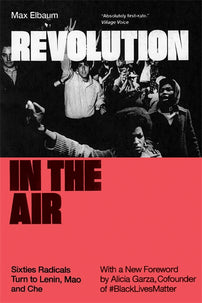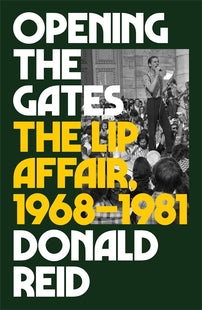The Long Japanese Sixties
A communist league of students founded in 1948 in Japan, the Zengakuren amassed power over two decades, creating tremendous tensions in the US-Japan Cold War alliance by challenging standard concepts of democracy, peace and the history of imperialism.

Conventional narratives of the Japanese student movement start with the mass demonstrations against the revision of the US-Japan Security Treaty of 1960 and end with the factionalism of the student movement and the violent crimes of small extremist groups such as the Red Army Faction. Yet, this commonly used chronological frame inadvertently fails to take into account the multilayered complexities of the history of the Japanese student movement. It also assimilated the Japanese student movement to Western notions and chronological frames of a New Left. Mark Kurlansky, for example, located the origin of the global 1968 student revolt in the lunch counter sit-in protests ignited by four African American students in Greensboro, North Carolina on February 1, 1960. He argued, “By 1968, all over the world, people with causes wanted to copy the civil rights movement. Its anthem, Pete Seeger’s ‘We Shall Overcome’ - a folk song turned labor song that Seeger had turned into a civil rights anthem when the sit-ins began in 1960 - was sung in English from Japan to South Africa to Mexico.”[i] While the tremendous influence that the American Civil Rights Movement had on protest movements abroad, including Japan, cannot be denied, this portrait of the global revolt of the 1960s fails to account for global historical diversities and local contrasts in nations such as Japan. Although the Japanese student movement shared important characteristics of the Western New Left, it was an anti-imperialist movement that had far deeper chronological roots extending back to the late 1940s. As a result, the movement was far more influenced by an anti-fascist sensibility born of memories of World War II and the democratic ethos of the US in that war – which Japanese citizens absorbed via the US occupation – than its American New Left counterpart.
During the US occupation of Japan, the leftist student movement took up the cause of democratization and demilitarization, organizing itself into a nationwide organization named Zengakuren, formally named Zen-Nihon Gakusei Jichikai Sōrengō (All-Japan Federation of Students’ Self-Governing Associations). By the late 1940s, the growing of Russo-American tensions forced Washington to moderate the vision of democracy and demilitarization it had advocated during the war. In US-occupied Japan, the powerful popular democratic upsurge, inspired by the US occupation’s democratization and demilitarization programs, continued without losing its intensity, even after US objectives of the occupation shifted its priority to combating Communism and establishing an economically self-sufficient center of anti-Communism in Asia. Zengakuren students emerged as the forefront of the popular movement to finish the unfinished revolution initiated by American occupation.
During the 1950s, the focus of the Japanese student movement turned to the Cold War alliance between the United States and Japan. The US-Japan Security Treaty (abbreviated as Anpo in Japanese), signed the same day as the peace treaty that ended the US occupation of mainland Japan in 1951 at San Francisco, guaranteed Japanese security through the presence of US military bases and facilities in mainland Japan and the US occupation of Ryukyu islands, the southernmost islands of the Japanese archipelago. With the outbreak of the Korean War, the geostrategic importance of the US military bases in Japan grew as its commitment to Pacific security increased. In 1955, the US and Japanese governments agreed to extend the runway of the US Tachikawa Airbase into the small town of Sunagawa to accommodate modern US jets. This was the beginning of the Sunagawa Struggle. Many residents feared that stationing these new jets would make the town a target in the case of a destructive, possibly nuclear, war between the superpowers, and so they resisted the plan. Zengakuren students, along with labor unions and leftist political parties, joined local residents’ protests against the runway extension plan. Despite the fact that many protestors, including Zengakuren students, were advocating demilitarization for peace, the governmental authorities viewed them as serving the Communist cause. The Los Angeles Times called the protests at Sunagawa “anti-America disorders” that were “obviously encouraged if not actually promoted by the recently revived Communist Party.”[ii] The movement against the extension plan triggered public debates over the US-Japan Security Treaty, setting the stage for the Anpo crisis of 1960.
This Anpo crisis of 1960 is one of the most cited Japan’s Cold War stories. By the fall of 1960, sixteen million Japanese people were reported to have participated in the demonstrations against the revision of the US-Security Treaty.[iii] As 1960 began, Zengakuren took more direct actions to block the signing of the revised security treaty. During the night on January 15, over 1,000 students stormed into the Haneda Airport, and about 700 of those occupied the lobby and barricaded themselves with chairs and tables to prevent Prime Minister Kishi Nobusuke from leaving for the United States to sign the revision of the treaty.[iv] On May 19, the anti-Anpo struggle entered a new phrase as Kishi’s LDP steamrolled the Security Treaty revision through the House of Representatives. Outside the Diet building, a large crowd of demonstrators surrounded the Diet premise guarded by 3,000 policemen.[v] The initial police report estimated the number of the demonstrators to be 7,000 while the opposition groups claimed it to be over 20,000. The protestors criticized Kishi’s “undemocratic” handling of the situation. Now, the movement against the security treaty raised the question of postwar democracy. Maruyama Masao, one of the most prominent postwar political philosophers, pointed out that the anti-Anpo struggle now posed the logic of “you must be either anti-Anpo or anti-democracy.”[vi] For Japanese student activists, the outcome of the anti-Anpo demonstrations resulted in mixed feelings – confidence gained from the large scale of public demonstrations that ultimately forced the Prime Minister Kishi to resign but also despair over the movement’s failure to stop the passage of the revised treaty.
By the mid-1960s, the youth/student world was revolting against US “imperialist” policy in Vietnam. In opposition to the war local, national and international protest movements converged and transformed student radicals into the global players of 1968. In a world engulfed by a wave of new radicalism, the engagement in local struggles with US power deepened the global consciousness of Japanese student radicals and impelled them to build transnational alliances with their counterparts in Europe and the United States. US military bases in Japan came under fire as outposts of new imperialism, but their presence in Japan also contained the potential to facilitate transnational flows of new radical thoughts. The Vietnam Veterans Against the War/Winter Soldier Organization (VVAW/WSO), originally founded in 1967 in New York, published the biweekly newspaper Freedom of Press and set up a bookstore near the Yokosuka naval base to allow American GIs to access pamphlets and films that were not made available by the military. Underground newspapers published by American GIs flourished in the areas that hosted US military bases in Japan. They include Kill for Peace and Freedom Rings in Tokyo, Semper FI in Iwakuni, Omega Press and Demand for Freedom in Okinawa to name a few. These newspapers became not only the source of information for antiwar GIs and activists, but also provided radical critique of the existing social structures and imperialism. A Black GI in Yokosuka wrote, “We have freedom but all our equal rights. This [the Vietnam War] is the white man’s war, not the black mans,” criticizing racial oppression at home in an issue of the Long Road to Freedom published by GIs in Yokosuka Naval Base.[vii]
By 1970, the Japanese student radicals increasingly engaged in the active importation of ideas and tactics from the protest movements abroad. The Third World and the United States had become the two major sources of inspiration for the Japanese student radicals. Victor Passy, reporting to National Guardian observed, “[Three Faction Zengakuren’s Chairman] Akiyama [Katsuyuki] took me to the big Zengakuren headquarters here. The walls are covered with pictures of Che Guevara, Vietnam and the Student Nonviolent Coordinating Committee.”[viii] The Third World revolutionaries and the black radicalism in the United States played a crucial role in transforming the concept of revolutionary subjectivity among the Japanese radicals. They offered a way to deal with the limitation of the classical Marxism through the employment of cultural categories such as race. The local-global convergence of radical activism was crucial in fashioning a new sense of power among the student radicals in Japan.
Emerging in the aftermath of WWII, the nascent Zengakuren student movement amassed power and energy, benefiting from the era’s popular democratization movements. Over two decades, the student movement created tremendous tensions in the US-Japan Cold War alliance by challenging standard concepts of democracy, peace and the history of imperialism that were increasingly shaped by the Cold War. The anti-imperial student movement of the long Sixties seemed to reach its ending in 1973. The revision of the US-Japan Security Treaty was automatically ratified in 1970, and the US occupation of Okinawa was officially ended in May 1972. It seemed not much effort was required for the United States to make an adjustment for the post-Occupation US-Japan alliance. The Japanese national consensus proved strongly in favor of the US-Japan alliance and maintaining US military bases, which were predominantly in Okinawa. These two major diplomatic events resulted in permeating the feeling that the struggles with the alliance between the American old Warriors and Japanese conservative government had been finalized.
[i] Mark Kurlansky, 1968: The Year that Rocked the World (New York: Ballantine Books, 2004), 84.
[ii] Los Angeles Times, September 14, 1955.
[iii] Wesley Sasaki-Uemura, Organizing the Spontaneous: Citizen Protest in Postwar Japan (Honolulu: University of Hawai’i Press, 2001), 16.
[iv] Tokyo Daigaku Shimbun reported the number to be 1,500 protestors were at Haneda on January 20, 1960; Japanese Public Security Intelligence Agency (Kōan Chōsachō) reported that 1,000 Zengakuren students stormed into the Haneda Airport in Kōan Chōsachō, Anpo Tōsō no Gaiyō: Tōsō no Keika to Bunseki, 165.
[v] Tokyo Daigaku Shimbun, July 11, 1960.
[vi] Maruyama Masao, “Sentaku no Toki,” [Time to Choose.] Tokyo Daigaku Shimbun, July 11, 1960.
[vii] “Message from a Black GI Inside Yokosuka Basement,” Long Road to Freedom. [The date of the publication is unknown, the message was writte on September 9, 1970]. Endō Yōichi Papers. S-3-408. Box 19. Research Center for Cooperative Civil Societies, Rikkyo University, Tokyo, Japan.
[viii] Vitor Passy, “Action in Tokyo…,” National Guardian, February 21, 1968.
[book-strip index="1" style="display"]

